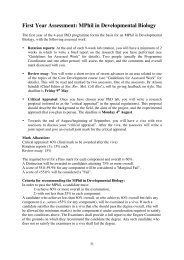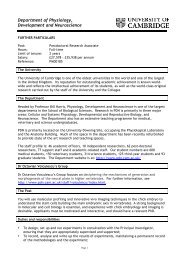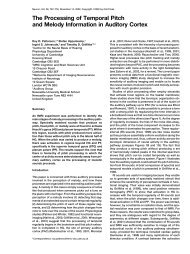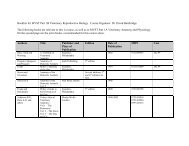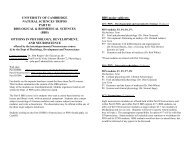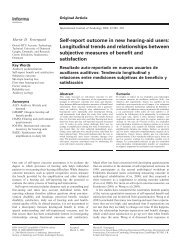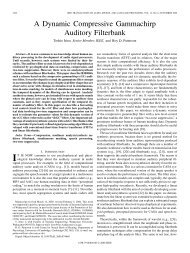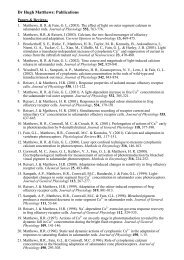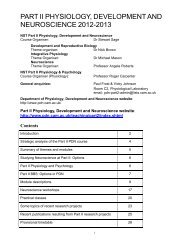FRIDAY MORNING, 20 MAY 2005 REGENCY E, 8:30 A.M. TO 12:00 ...
FRIDAY MORNING, 20 MAY 2005 REGENCY E, 8:30 A.M. TO 12:00 ...
FRIDAY MORNING, 20 MAY 2005 REGENCY E, 8:30 A.M. TO 12:00 ...
You also want an ePaper? Increase the reach of your titles
YUMPU automatically turns print PDFs into web optimized ePapers that Google loves.
5aPP3. Comparing linear regression models applied to psychophysical<br />
data. Zhongzhou Tang, Virginia M. Richards Dept. of Psych., Univ. of<br />
Pennsylvania, Philadelphia, PA 19104, richards@psych.upenn.edu, and<br />
Andrew Shih Univ. of Pennsylvania, Philadelphia, PA 19104<br />
Relative weights for a profile analysis task were obtained using four<br />
regression/classification models; correlation coefficients, linear regression,<br />
logistic regression and probit regression. The aim of the study was to<br />
examine the impact of the choice of model on the accuracy and the efficiency<br />
with which the relative weights were determined. A yes/no task was<br />
used with observers indicating whether or not there was an increment in<br />
level to the central component of an 11-component standard. On each<br />
presentation the amplitudes of the individual components of the complex<br />
were randomly perturbed using draws from a normal distribution. When a<br />
large number of trials <strong>12</strong>50 were used to estimate the relative weights,<br />
the four methods generated nearly identical weight estimates. When<br />
smaller numbers of trials were used 1<strong>12</strong>, the different methods generated<br />
patterns of relative weights that were largely similar, and the patterns<br />
deviated only modestly from the large-number solution. In terms of efficiency,<br />
the error boundaries of the different methods were nearly indistinguishable.<br />
All in all, the number of trials needed to obtain statistically<br />
significant weights is sufficiently large that there is no apparent advantage<br />
of using one method over the others. Work supported by NIH/NIDCD.<br />
5aPP4. The difference in auditory memory between young and aged<br />
listeners with normal hearing. Bruce Schneider, James Qi Dept. of<br />
Psych., Univ. of Toronto at Mississauga, Mississauga, ON, Canada L5L<br />
1C6, bschneid@credit.erin.utoronto.ca, Juan Huang, Xihong Wu, and<br />
Liang Li Peking Univ., Beijing 1<strong>00</strong>871, China<br />
The perceptual fusion of a noise with its delayed copies implies that<br />
there is a memory for maintaining a detailed representation of an arbitrary<br />
waveform. This auditory memory would be important for perceptually<br />
grouping correlated sounds and segregating uncorrelated sounds in noisy,<br />
reverberant environments, in which older listeners find it much more difficult<br />
than younger listeners to process signals. To determine the temporal<br />
extent of the auditory memory and whether it is affected by aging, this<br />
study investigated the detection of a break in correlation between two<br />
correlated broadband noises in younger and older listeners with normal<br />
hearing. The results show that younger listeners could detect a 1<strong>00</strong>-ms<br />
break in correlation up to interaural delays ranging from 6.3 to 23.0 ms,<br />
suggesting that higher-order central mechanisms beyond the brainstem<br />
delay lines are likely to be involved in maintaining a memory trace of the<br />
fine details of the acoustic waveform. Aged listeners, however, could detect<br />
the break up to interaural delays ranging only from 6.7 to 9.7 ms,<br />
indicating the age-related decline in auditory memory. This decline may be<br />
one of the main causes leading to perceptual difficulties experienced by<br />
older listeners in noisy, reverberant environments. Work supported by<br />
NSERCC and MSTC.<br />
5aPP5. About the neglected auditory abilities within psychological<br />
tests of intelligence. Jenny Papenbrock, Kristin Seidel, Susanne Weis,<br />
and Heinz-Martin Suess Dept. of Psych., Univ. of Magdeburg, Pfaelzer<br />
Platz, Geb. 24, Postfach 41<strong>20</strong>, 39016 Magdeburg, Germany,<br />
si-projekt@gse-w.uni-magdeburg.de<br />
Auditory abilities play an important role in human intellectual abilities.<br />
In his model of human cognitive abilities Carroll 1993 identified a separate<br />
domain of auditory ability. Despite their theoretical and practical relevance,<br />
these abilities were mainly excluded in psychological tests. In<br />
order to compensate for this lack we developed a test which is intended to<br />
complement existing intelligence tests. To measure general auditory abilities<br />
already existing materials Stankov and Horn, 1980 were used along<br />
with newly developed auditory tasks. Our test includes nonverbal tasks<br />
containing only tones as well as auditory textual tasks using spoken words.<br />
We expect that the auditory tasks measure a separate ability and therefore<br />
can make an important contribution to complement already existing intelligence<br />
tests. To demonstrate that the test is able to measure different<br />
aspects of auditory abilites pure tone tasks should be distinguishable from<br />
auditory textual tasks. 1<strong>20</strong> subjects worked on the auditory test as well as<br />
on a well-established test of intelligence Test for the Berlin Intelligence<br />
Structure Model, BIS-4; Jger, S & Beauducel, 1997 which operates with<br />
written, numerical and figural material. Main results of our study are reported<br />
and implications for future research concerning psychological ability<br />
tests are discussed.<br />
5aPP6. Contributions of individual components to the overall<br />
loudness of a multi-tone complex. Lori Leibold, Samar Khaddam, and<br />
Walt Jesteadt 555 North <strong>30</strong>th St., Omaha, NE 68131,<br />
leiboldl@boystown.org<br />
The contributions of individual components to the overall loudness of<br />
a multi-tone complex were examined in a two-interval, loudness-matching<br />
task. Stimuli were five-tone complexes centered on 1<strong>00</strong>0 Hz, with six<br />
different logarithmic frequency spacings, ranging from a frequency ratio<br />
of 1.0<strong>12</strong> to 1.586. Stimuli were presented for <strong>30</strong>0 ms 10 ms rise/fall. The<br />
overall level of the standard complex was fixed at 60 dB SPL 53 dB/<br />
component. Levels of the individual components of the comparison complex<br />
were selected at random from a rectangular distribution with a range<br />
of <strong>20</strong> dB. Ten 1<strong>00</strong>-trial blocks were run for each frequency-spacing condition.<br />
Perceptual weights were computed by calculating the point-biserial<br />
correlation between the difference in the level of each component across<br />
the two intervals and the subjects response. When all components fell<br />
within the same critical band, weights varied little across components. In<br />
contrast, the range of weights increased with increasing frequency separation,<br />
with increasing weight given to the lowest and highest frequency<br />
components. The audibility of individual components was determined by<br />
measuring detection thresholds for each component in the presence of the<br />
remaining four components. A strong relation between component weight<br />
and audibility was observed for all but the narrowest spacing conditions.<br />
5aPP7. Differences in loudness of tone complexes with positive and<br />
negative Schroeder phase. Manfred Mauermann and Volker Hohmann<br />
Medizinische Physik, Institut fr Physik, Fakultt V, C.v.O Universität<br />
Oldenburg, 26<strong>12</strong>9 Oldenburg, Germany<br />
Tone complexes with positive (m) and negative Schroeder phase<br />
(m) have an identical long-term spectrum, the same temporal envelope<br />
but are inverted in time. They show large differences in masking efficiency<br />
most probably being related to a different cochlear representation. The<br />
current study investigates to which extent loudness perception is affected<br />
similarly by the different phase characteristic of m/m stimuli. Therefore,<br />
the loudness of m/m stimuli 1.6 octave bandwidth was<br />
matched in seven normal hearing and three hearing impaired subjects. In<br />
the first experiment the fundamental frequency f 0 of the tone complexes<br />
was varied from 2–1536 Hz for different center frequencies at a soft level<br />
of the reference signal (m). In normal hearing subjects the m stimuli<br />
needa6dBhigher level to be perceived as equally loud as the respective<br />
m stimuli for f 0 in the range of 24–96 Hz. In the second experiment<br />
the difference in loudness of m/m was investigated as function of the<br />
of the reference-stimulus level 5–80 dB SL at a center frequency of<br />
2660 Hz and f 0 at 48 Hz. The largest differences in loudness were found<br />
for levels between 40–60 dB, clearly reduced for higher and lower levels<br />
of the reference stimulus.<br />
5a FRI. AM<br />
2597 J. Acoust. Soc. Am., Vol. 117, No. 4, Pt. 2, April <strong>20</strong>05 149th Meeting: Acoustical Society of America 2597



